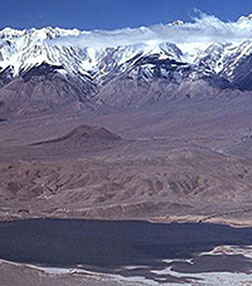- Number 410 |
- March 31, 2014
Distant dust and atmospheric rivers increase flooding in California

Snow melt from the Sierra Nevada Mountains
is the major fresh water supply for California.
Photo courtesy of Creative Commons license.
Overseas dust increases the Sierra Nevada Mountains snowpack and atmospheric rivers cause it to rapidly melt, according to scientists at DOE's Pacific Northwest National Laboratory and their colleagues. The team reached this finding by modeling two cloud conditions under the influence of atmospheric rivers, narrow bands of moisture transported from the tropics, during a field experiment called CalWater 2011. Atmospheric rivers are the primary cause of flooding in California by dumping rain and accelerating snowmelt in the mountainous terrain. Dust blown in possibly from Asia and Africa increases the formation of snow in winter clouds over California and increases rain- and snowfall by 10 to 20 percent. However, local pollution from California cities and the Central Valley has little impact on snowfall. Further, local pollution's influence on rain from warm clouds heavily depends on cloud conditions and the strength of a low level jet, often associated with atmospheric rivers, that blows parallel to the Sierra Nevada Mountains.
“We used observational data captured in the clouds and on the surface to better understand how cloud ice forms in the presence of dust particles and simulated this process in models,” said Dr. Jiwen Fan, PNNL atmospheric scientist and lead author of the study. “We compared the impacts of long-range transported dust to local pollution from coastal cities and the Central Valley on cold-season precipitation in contrasting cloud and meteorological conditions.”
The largest source of fresh water for irrigation and other purposes in California is snowmelt from the Sierra Nevada Mountains. Regional water resource managers must understand the environmental and climate influences on California's water supply sources. This need propelled the CalWater 2011 field campaign. Understanding the factors that impact precipitation and mountain snowpack will help improve regional climate predictions and far-reaching effects on people and food supplies.
In the future, a second field campaign, led by Dr. Ruby Leung at PNNL in collaboration with a larger team of multi-agency and university researchers, will be conducted over the same region, but with additional measurements over the Pacific Ocean. Researchers will collect more data to systematically study atmospheric rivers and aerosols' impact on snow and regional precipitation in California and improve models to better simulate aerosol effects on regional and global precipitation.
The research team, led by PNNL, was from Colorado State University, The Hebrew University of Jerusalem, National Oceanic and Atmospheric Administration, Scripps Institution of Oceanography, UC San Diego, NASA Langley Research Center, Science Systems and Applications, Inc., and State University of New York at Albany.
The California Energy Commission (CEC) and DOE's Office of Science as part of the Regional and Global Climate Modeling program funded the study. The G-1 is base-funded by the DOE's Atmospheric Radiation Measurement Climate Research Facility. The CEC supported deploying the G-1 during the CalWater campaign. Computational simulations were done using PNNL Institutional Computing resources.[Kristin Manke, 509.372.6011,
kristin.manke@pnnl.gov]
